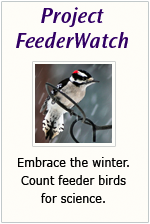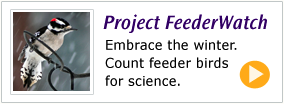If you're looking for ways to bring more nature into your everyday life, getting involved with a citizen science project is a great way to do that. Citizen science is where ordinary folks help on a genuine scientific investigation, usually by contributing their observations and/or labors to a growing bank of information. Naturalists and other scientists can use this huge amount of data to see broad trends and changes occur that they might not have seen otherwise, since it's pretty expensive to travel all over the country observing birds or butterflies or whatever the subject may be.
Thus anybody can actually contribute in a small way to scientific discoveries, which I think is pretty cool. Plus observing nature is fun just on its own! Having a framework like a specific project and goal helps keep me motivated and focused, so I thought it might do the same for others. One of my favorite citizen science projects is Feederwatch.
Basics of participating in Feederwatch
Feederwatch is run by the Cornell Lab of Ornithology and works like this: backyard birders observe their bird feeders from November through March and report how the birds they see each week. You don't have to watch and count every day, either, just two consecutive days each week. Pretty simple! You do have to pay a fee to join the project, $18 if you're not already a member of the Cornell Lab of Ornithology. If that's out of your reach, don't despair! I have a few cost-saving ideas for you in my Tips and Tricks section at the end of this post. |
| I wish I saw this Rose-breasted Grosbeak during count season! Sorry for the picture quality, it was taken through our very old windows. |
How I like to count birds
I like to do my counting in the early mornings while I'm sipping my coffee. It's very peaceful watching the chaos of hungry birds swirl through my yard. I print out tally sheets at the beginning of each Feederwatch season so I just make hash marks as I see birds, rather than having to write out the names by longhand. Most years I've printed new pages each week so I end up with a thick binder of observation charts at the end of the season.Another way you could do this would be to print a single chart, get a plastic page protector, and then do the hash marks in dry-erase marker each week so you can then erase them and start fresh after you've reported your data. You could even do it all electronically, on a tablet or something. I admit I'm more old-school and still like tally sheets.
 |
| If you're lucky, maybe you'll see an unusual leucistic bird like this white one I nicknamed the Ghost Finch! |
Collecting Data
Here's the tally sheet I created for my watch days. It includes my most common feeder birds with extra room to write in new species at the bottom, and lots of room for hash marks beside each species. Of course you can make your own tally sheet that fits your local birds. If you live on the east coast of the U.S., though, this list should be enough to get you started.
I find it's really important to report your data promptly, rather than wait until the end of the season to report it. Two years in a row I did Feederwatch but never got around to reporting my data. Whoops! It was still fun. So maybe the clipboard and page protector would be a better motivator for reporting in that case, since you'd have to report the data before you erase it for the next week. A page protector would save a lot of paper, too.
For Feederwatch, you'll also need to report basic weather conditions as well as bird totals: max and min temp, any precipitation, percentage of the ground covered by snow, and so forth. Weather Underground provides a historical record that's searchable by date, including temps, wind, and precipitation in case you forgot to note it when you were watching the birds.
Equipment you'll need to participate in Feederwatch
Inside:- bird book(s)
- binoculars
- tally sheet (and page protector if you choose)
- pen and clipboard
- A comfy vantage spot near a window so you can see as much of the yard as possible.
- bird feeders
- bird seed
- suet cakes (if you have a suet feeder)
- optional other bird-attracting structures and/or plantings, such as
- an evergreen shrub for cover
- a bird bath to provide water
- a fruit-bearing tree for fruit-eating birds
 |
| I usually attach extra branches from our Christmas tree above the feeders to keep some of the snow off them. Waste not, want not! |
Tips and Tricks for Feederwatch
- As I mentioned, the annual fee to participate in Feederwatch is $18. For that you get a poster of common feeder birds, a kit to help you tally birds, and of course access to all of the data entered plus the annual summary report. If you can't afford the fee, however, you might ask your favorite nature center if they would like to participate. Then you (and maybe some of the staff) could count there. I have even seen some nature centers make a fun weekly program out of this. It's great for beginning birders and for families just getting into birdwatching.
- If you've never fed birds before, the Feederwatch web site has lots of helpful suggestions for what and where to feed them, as well as what else you might provide for the birds (water, shelter, etc.). Check to see if a nearby store specializes in birdfeeders as well, such as Wild Bird Centers (a large chain in the US and Canada), or a local independent store like my favorite One Good Tern in Alexandria, VA. They'll not only have the supplies you need, but probably can offer helpful advice for getting started.
- Other ways to control your costs:
- Does your neighbor feed the birds already? If so, maybe he or she would be willing to partner with you, or at least let you watch the birds in his or her yard.
- Even if your local nature center doesn't participate in the Feederwatch project, if they already put out seed for the birds you could still head over there each week to observe. They might even appreciate your data at the end of the year so they know more about what kind of birds use the feeders!
- Do please make sure to support the nature center in any way you can if you do this: participating in volunteer clean-up days there, spreading the word about them to all of your friends and neighbors, and so forth. Maybe they even need a volunteer to fill the feeders each morning! It would be nice to offer.
- Different kinds of seed may attract different kinds of birds. A large variety of birds enjoy black-oil sunflower seeds, though, so that's a good kind to start with. Suet feeders are very popular too.
- If it gets below freezing in your area, a heated bird bath would be very popular for thirsty birds.
- Be patient if you've never had feeders in your yard before, it may take the birds a few weeks to find the lovely buffet you're providing.
- If you can, offer more than just food in your yard. Fresh water is very important, especially in the winter when a lot of natural sources might freeze. Also birds will appreciate shelter and a variety of places to perch near the feeder while they wait their turn.
- You could even reuse your Christmas tree or other leafy decorations when you're done with them-- prop the tree securely against your mailbox, for example; or wire evergreen branches like pine and holly above the feeder like I did in the photo above, so they shelter the feeder from snow and rain.
The Cornell Lab of Ornithology also runs All About Birds, which provides lots of great info about birds you might see, including how to decide between certain tricky birds like purple and house finches, or Cooper's and Sharp-shinned Hawks. Even if you don't participate in Feederwatch I highly recommend checking out their website.
 |
| The best bird I've had during count season so far was this Pine Warbler. It stuck around for several days this January enjoying my suet feeder. I hope it comes back this year! |
Enjoy watching and counting your backyard birds! I'd love to hear your comments about the experience. What's the best bird you've seen in your yard so far?
Beware, though, birdwatching can be addictive! :-) So can helping with citizen science projects. I love feeling like I'm contributing something meaningful to the world, don't you?
Linking up with Saturday's Critters




Some lovely ideas here.
ReplyDeleteHi Joyful, thanks for stopping by. Looks like you've had a pretty busy week too. I especially liked your textural photo of the fallen autumn leaves. Pretty!
DeleteHi Jodi, this was a very interesting read. Thanks for visiting, I've enjoyed mine here and have put your blog on my blog roll as I would like to come back. Thank you for the info on Huntley Meadows. I shall have to remember about the turtles. Have a great week :)
ReplyDeleteHello Jodi, birdwatching can be addicting. It is nice you are participating in this citizen science project with Cornell. Great ideas and tips! I like the grosbeak, cardinal, hawk and the pine warbler photos. Thank you for linking up and sharing your post. Have a happy day and week ahead!
ReplyDeleteHi Denise, glad you're enjoying your time here. I think Huntley Meadows will always be one of my favorite parks. If you ever want some company there, let me know! :-)
ReplyDeleteHi Eileen, thanks for stopping by. The pine warbler really made my winter last year, I'd never seen one in my yard before! Same with the grosbeak. I've been watching some of Cornell's feedercams lately; I wish I could get their gorgeous pine grosbeaks and evening grosbeaks to visit me here in Maryland!
ReplyDelete